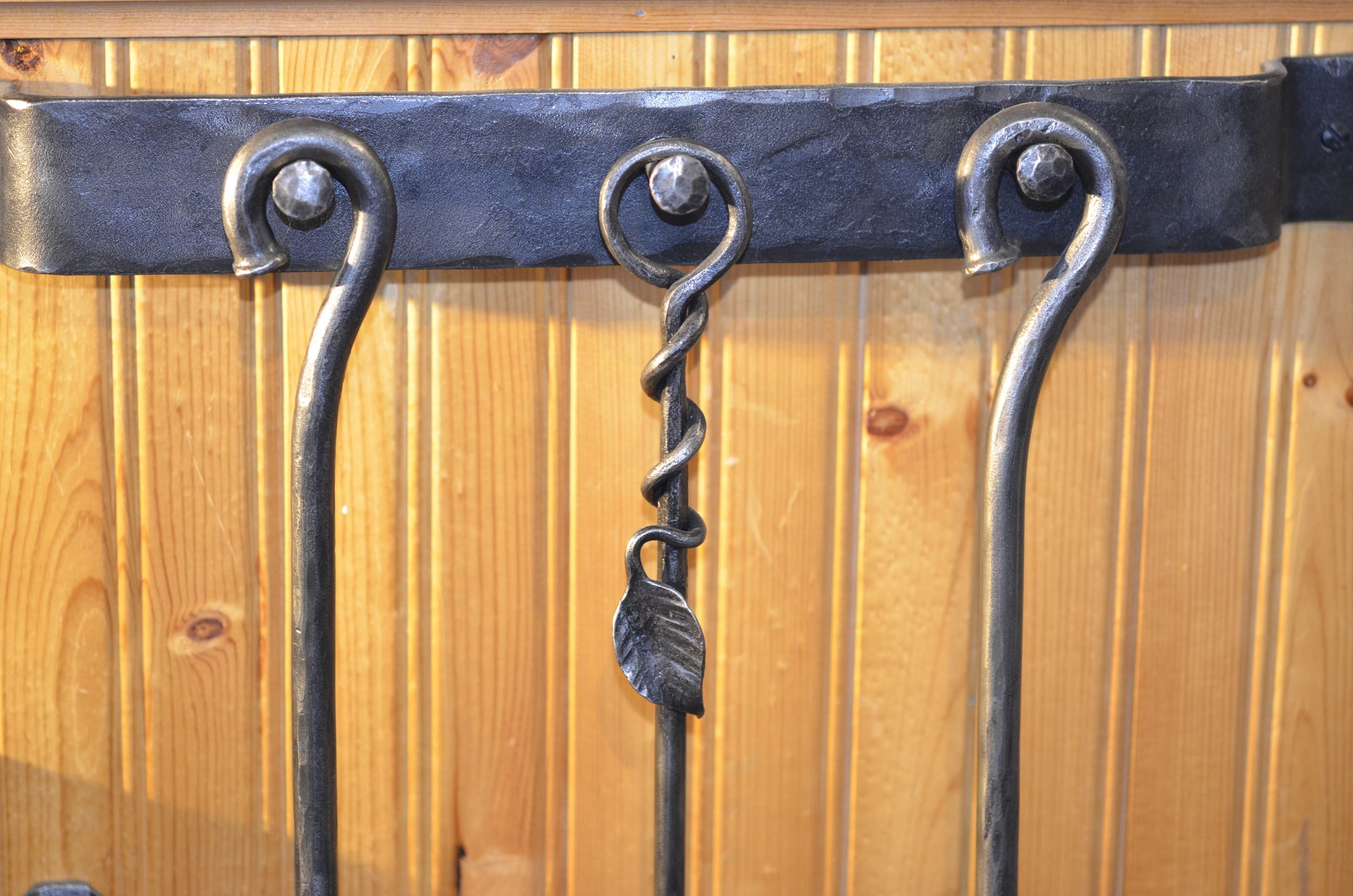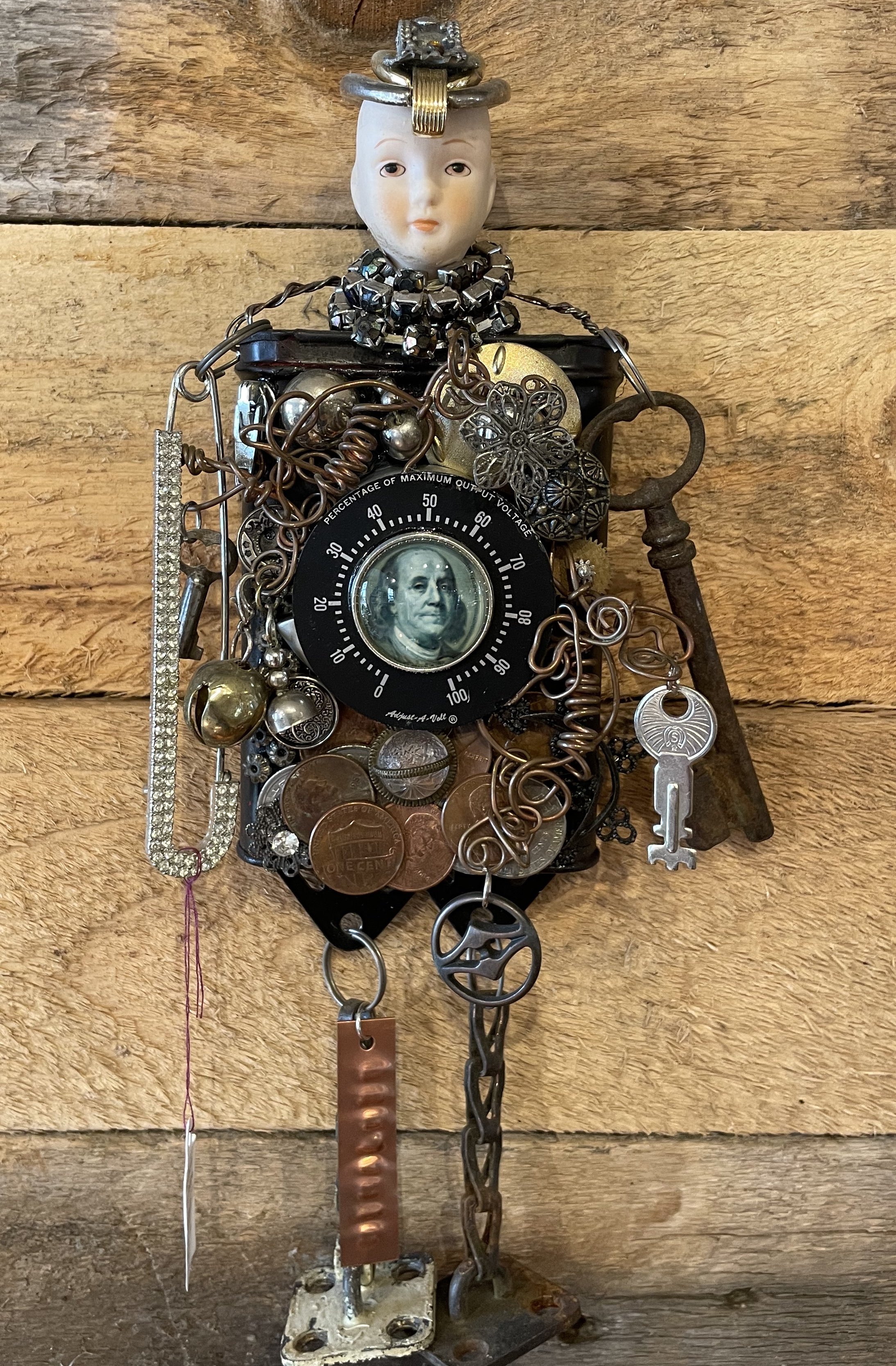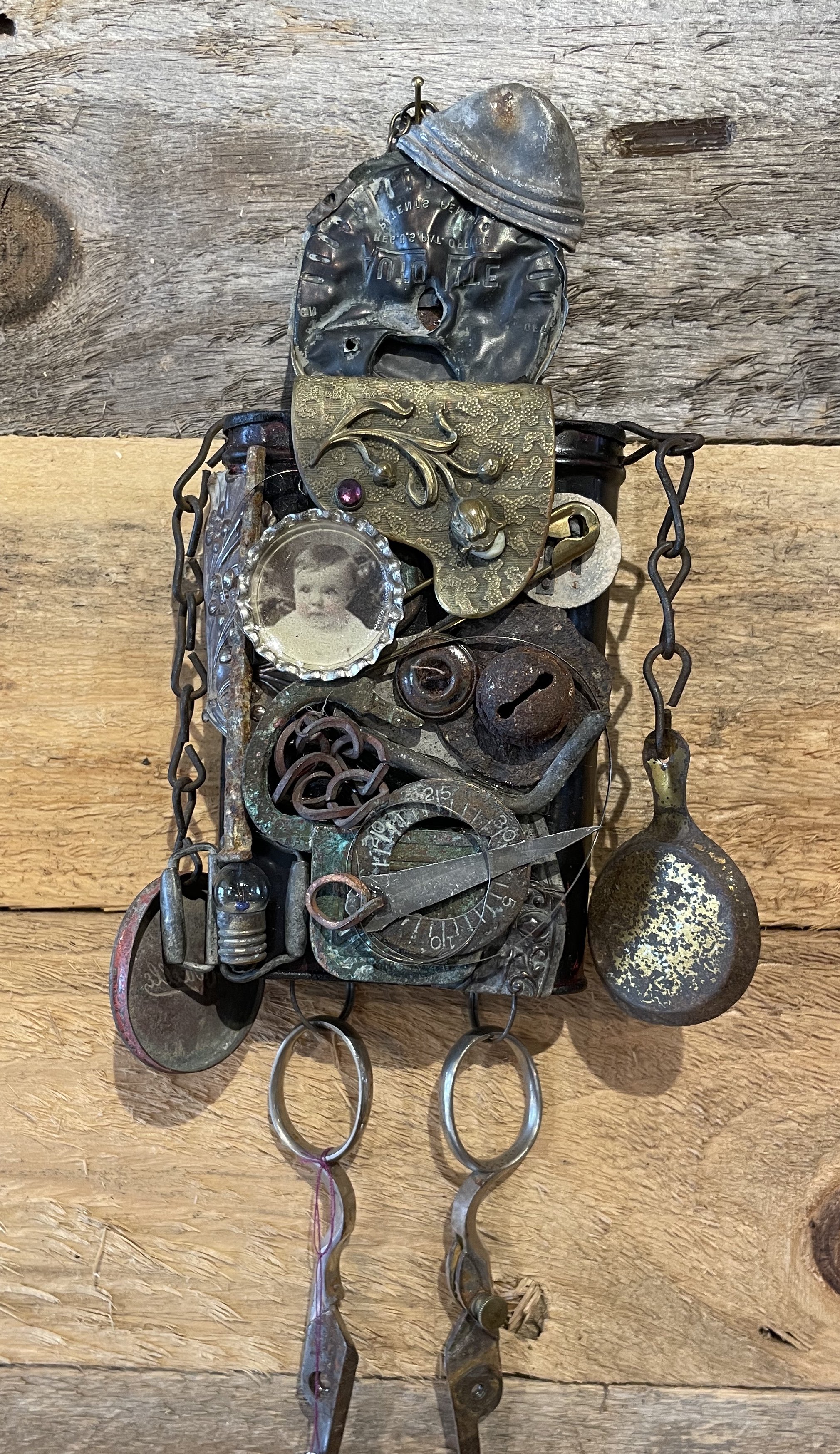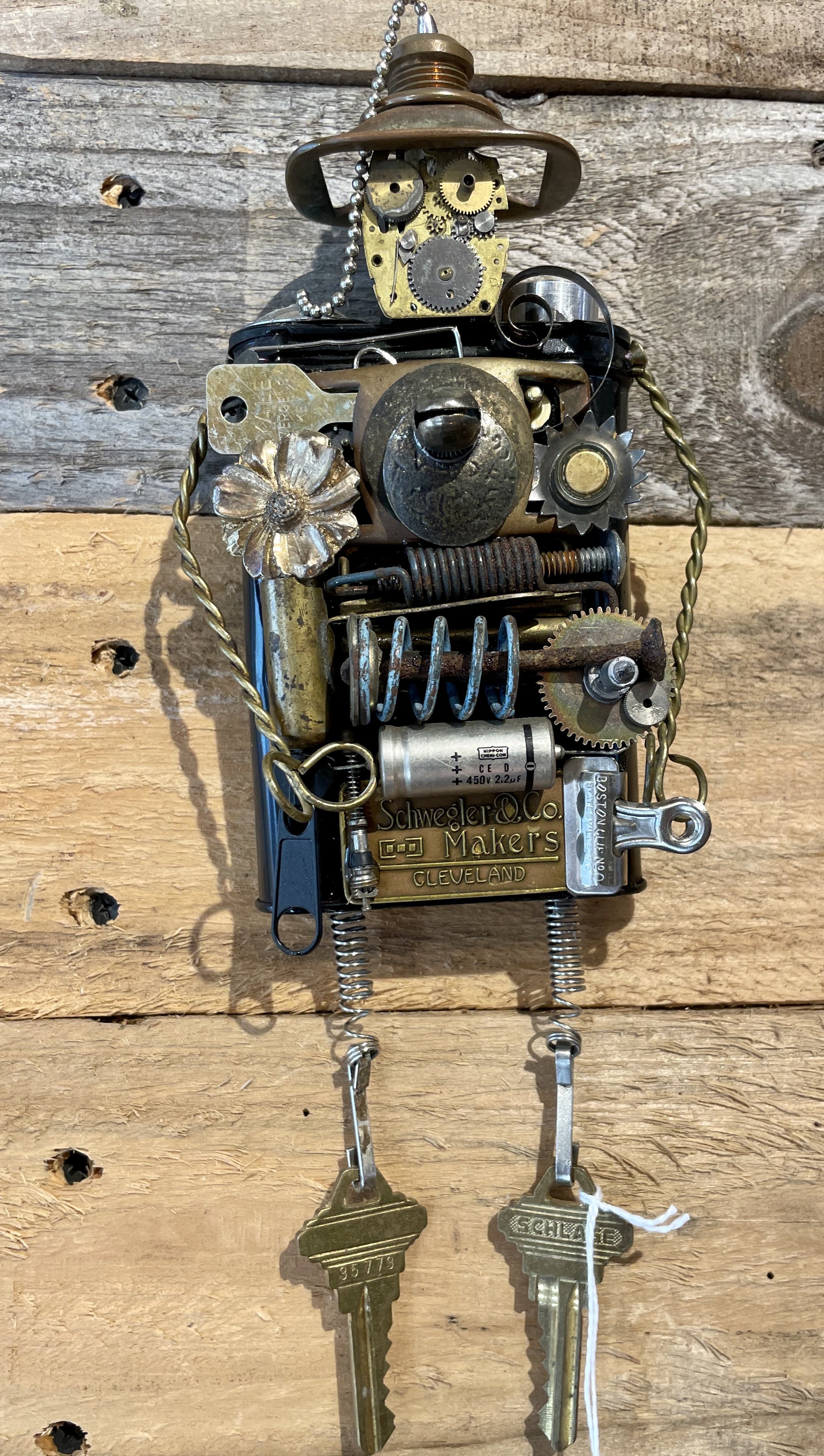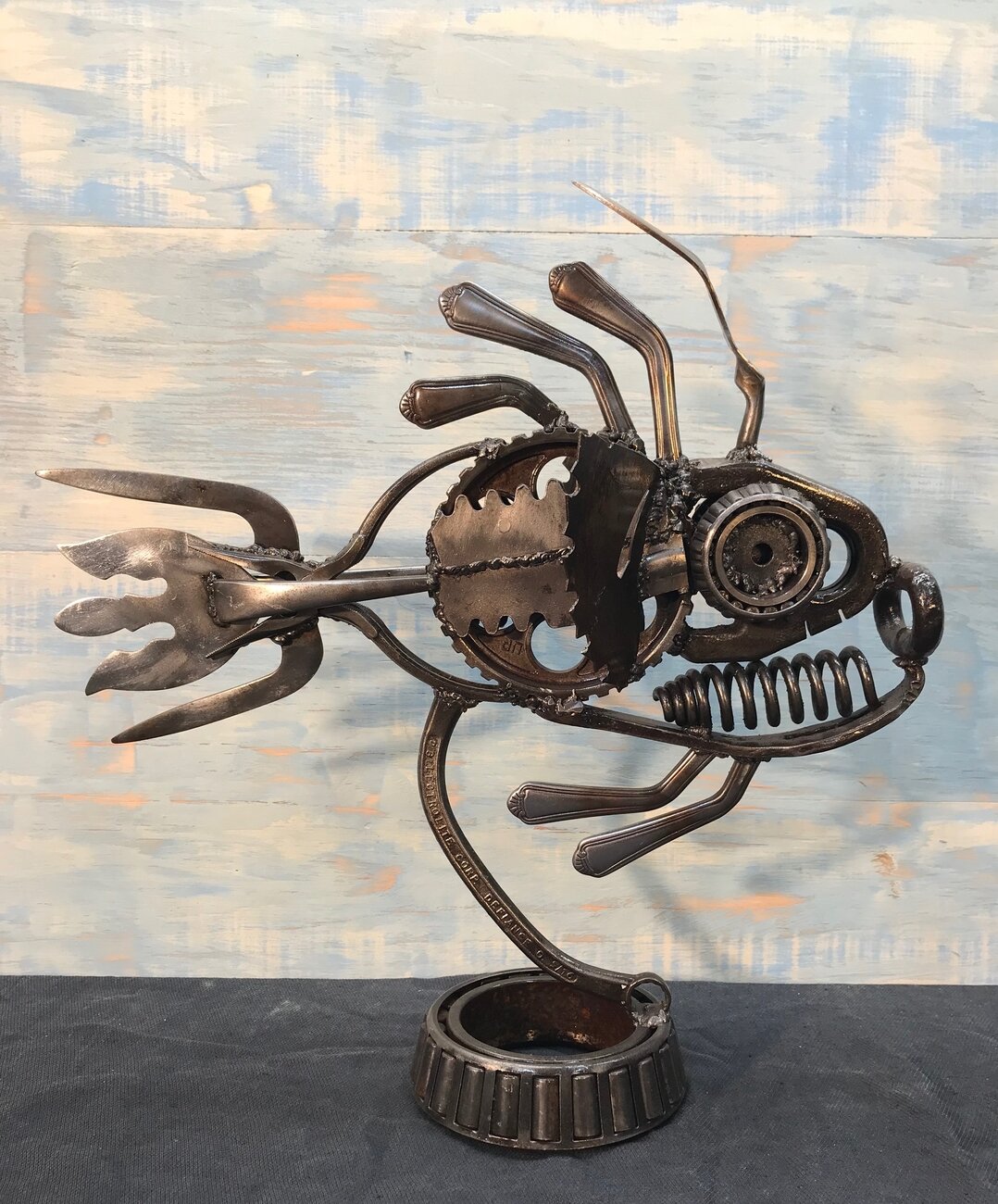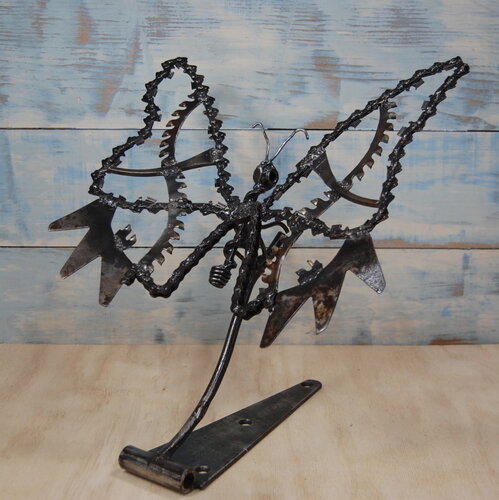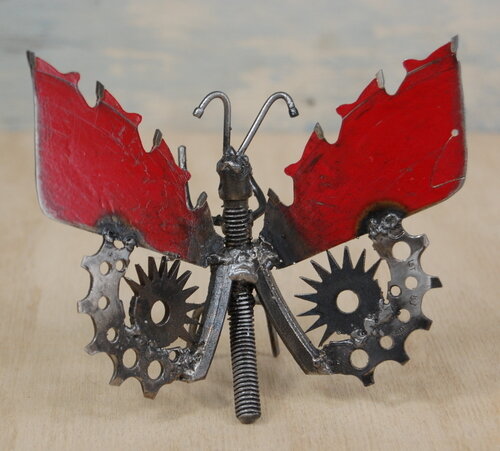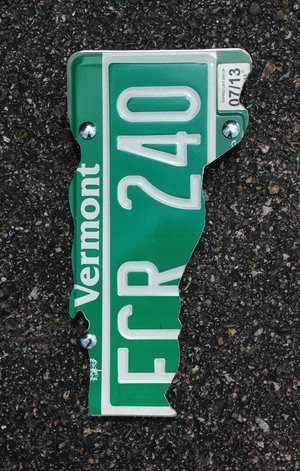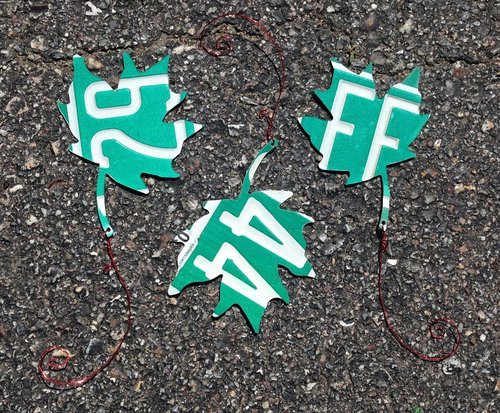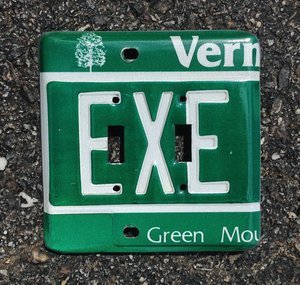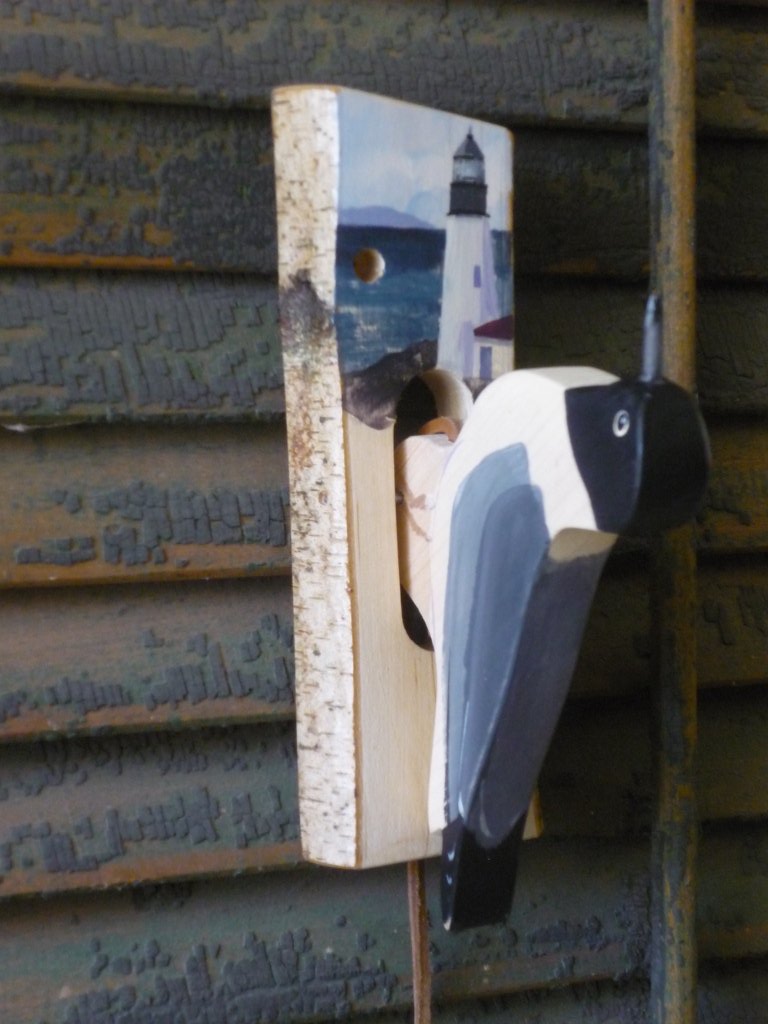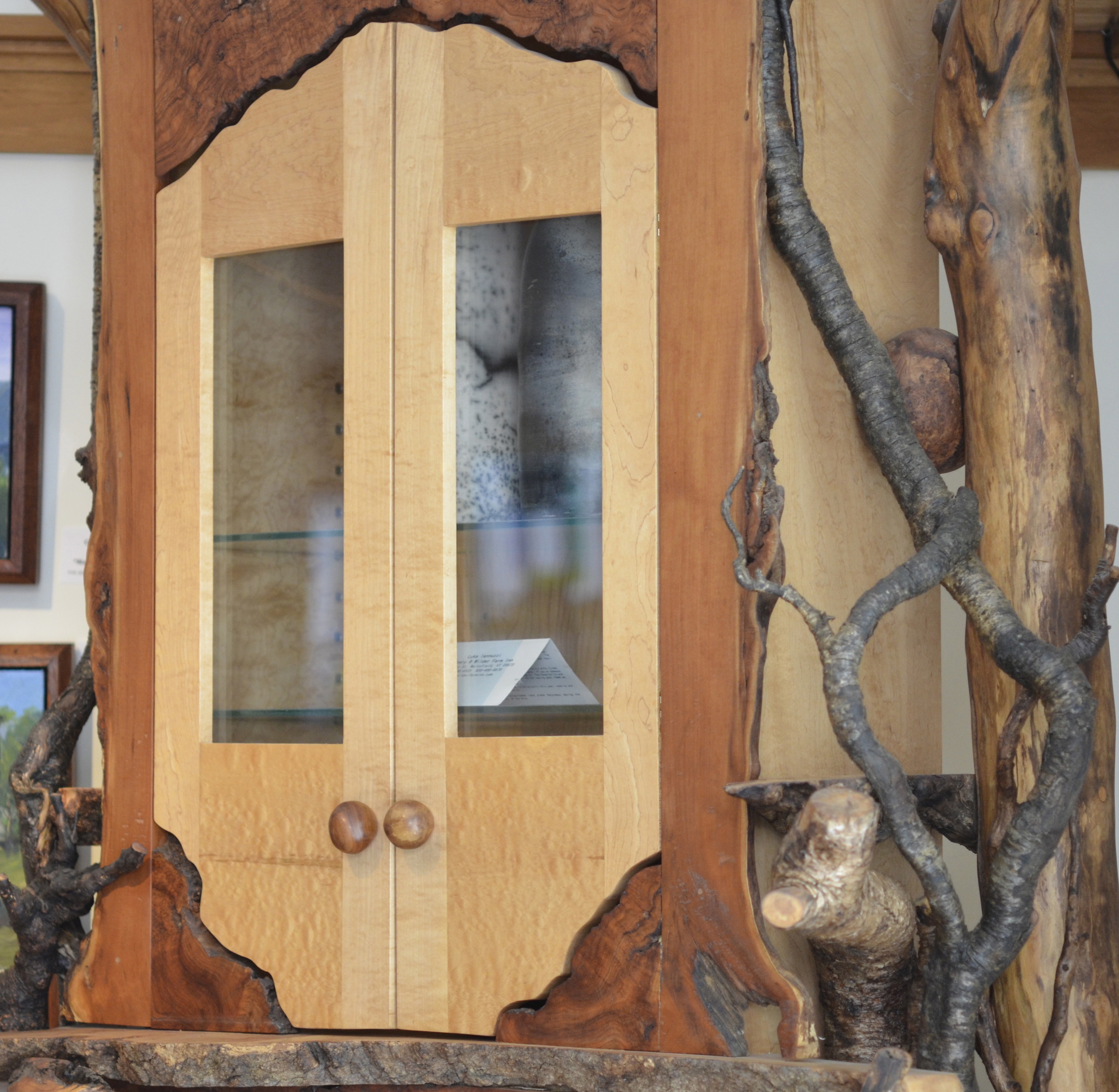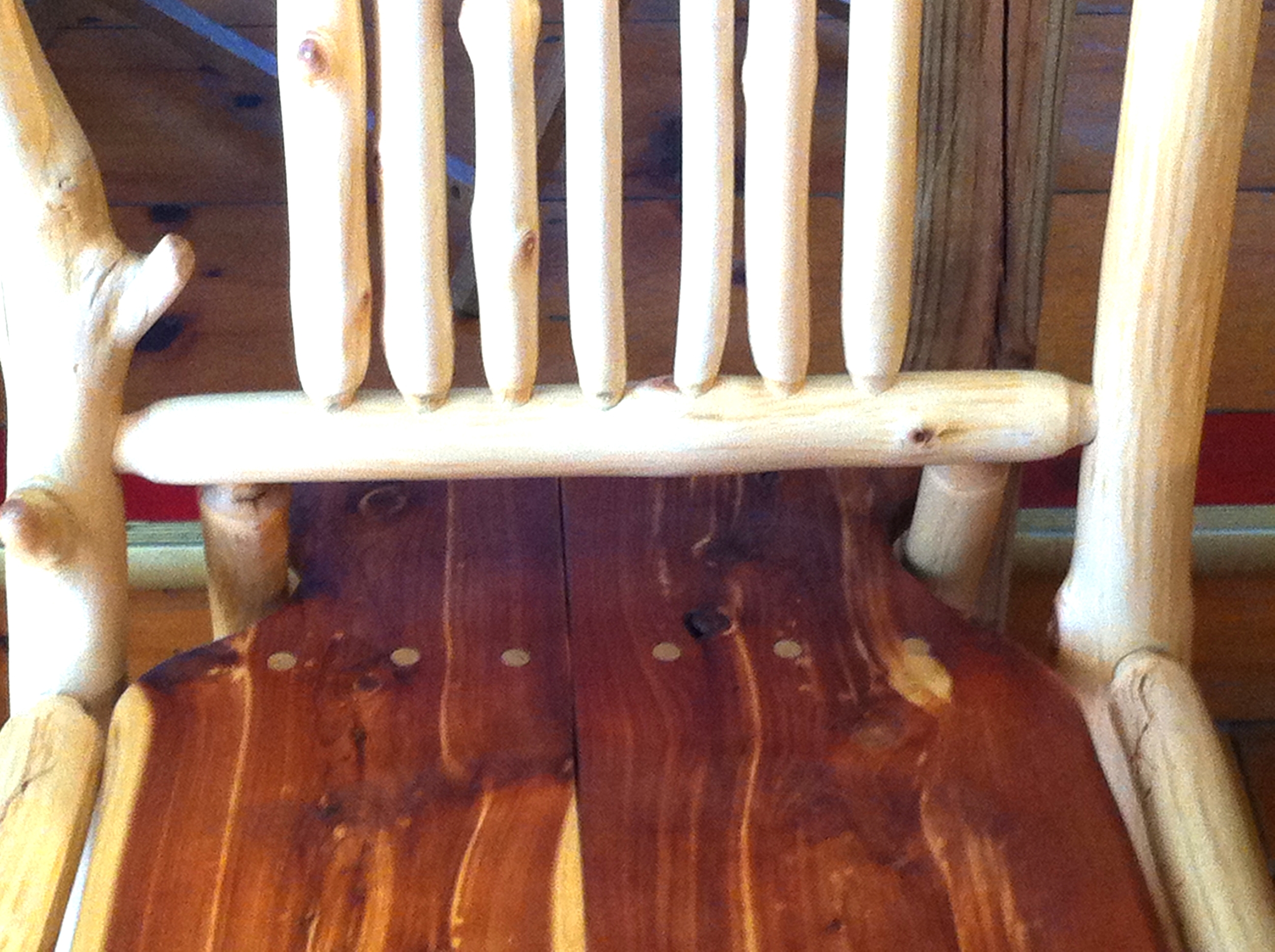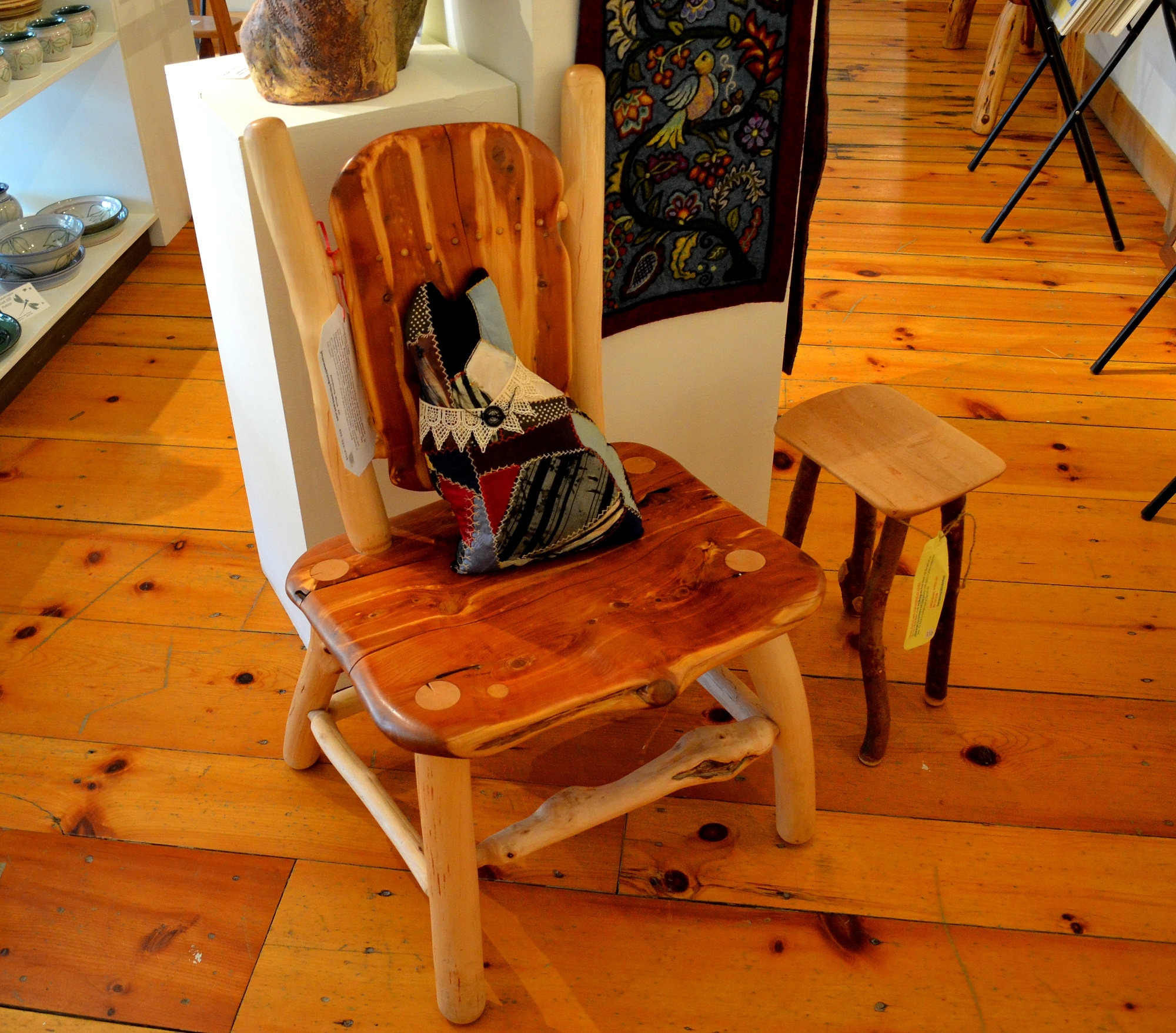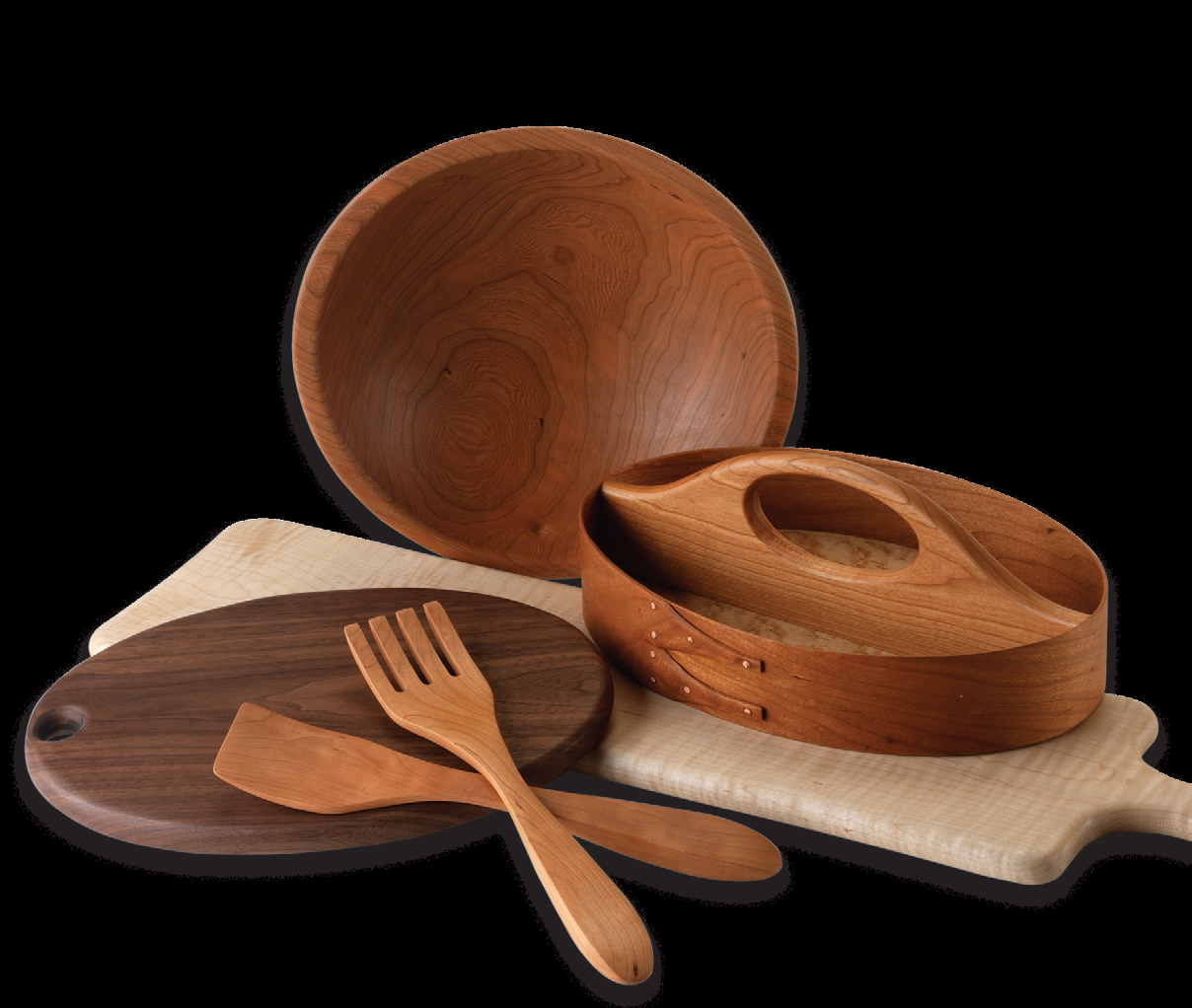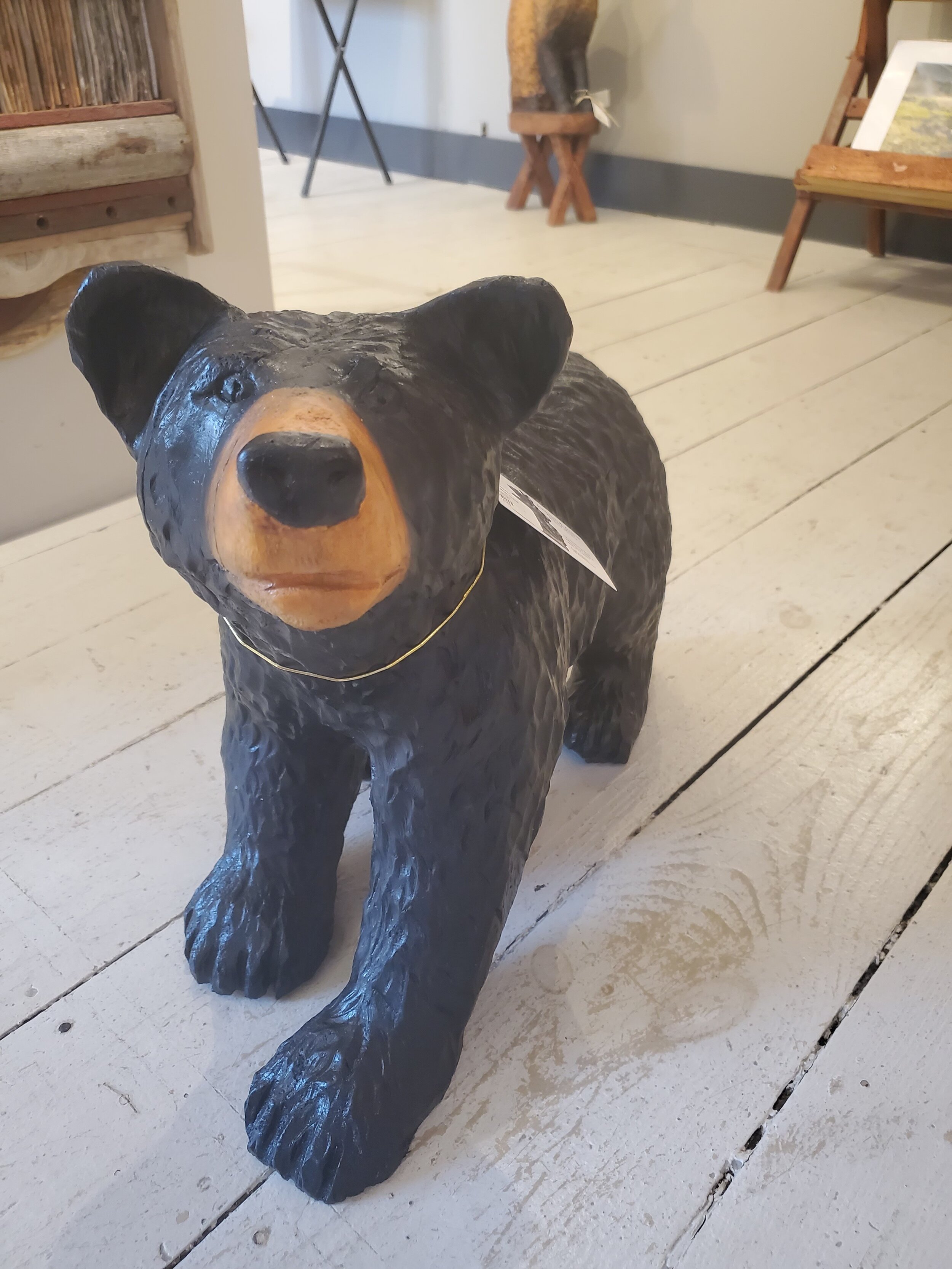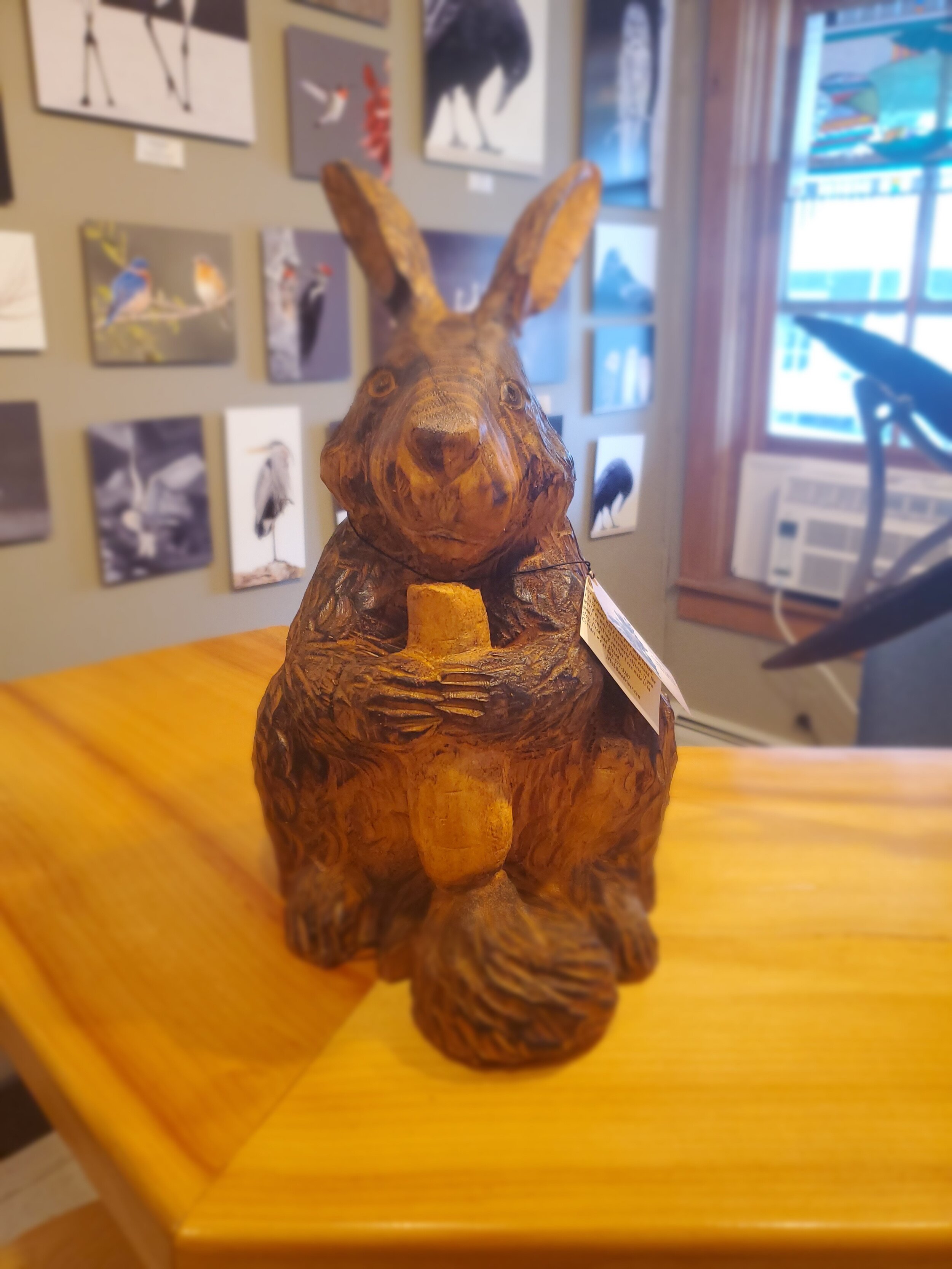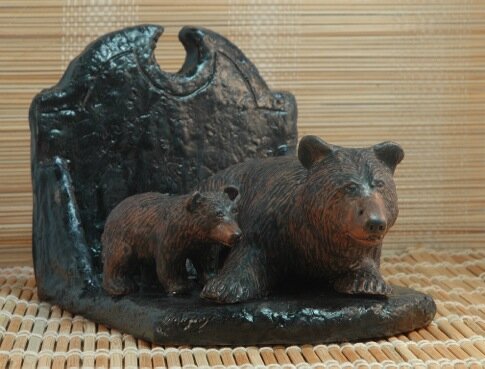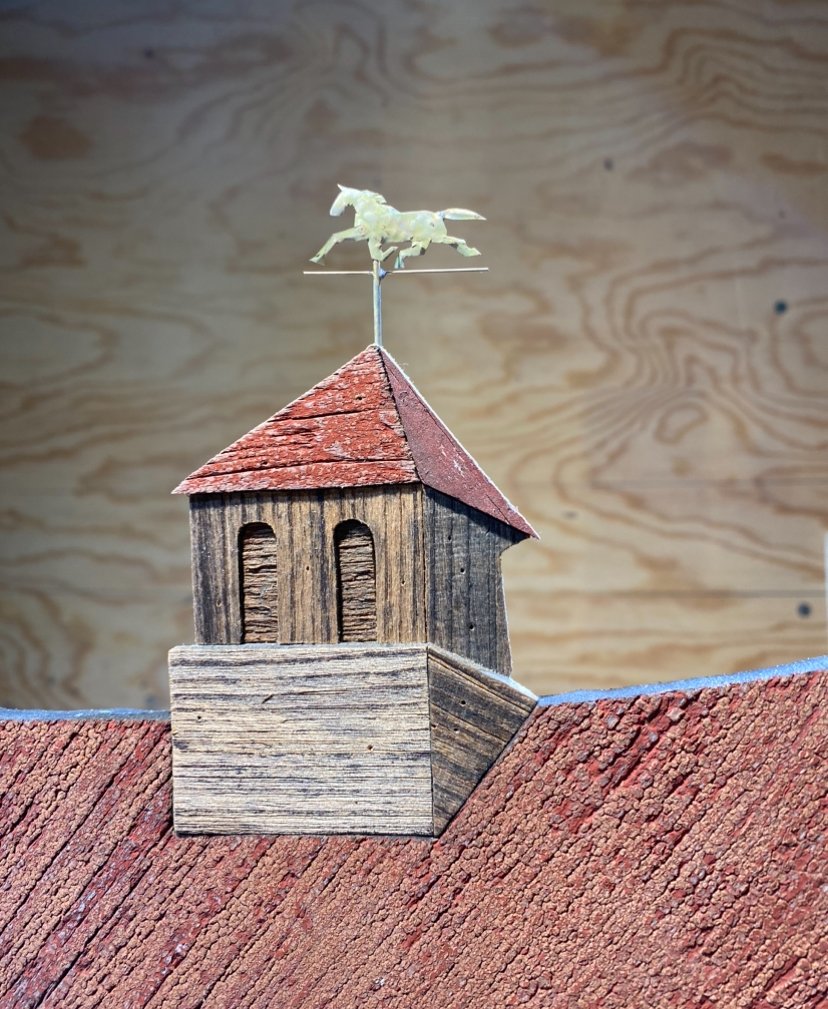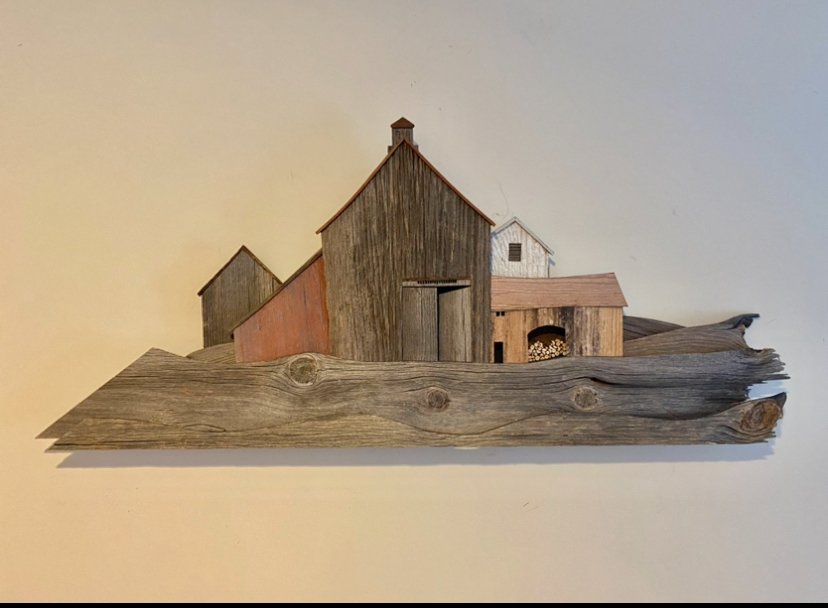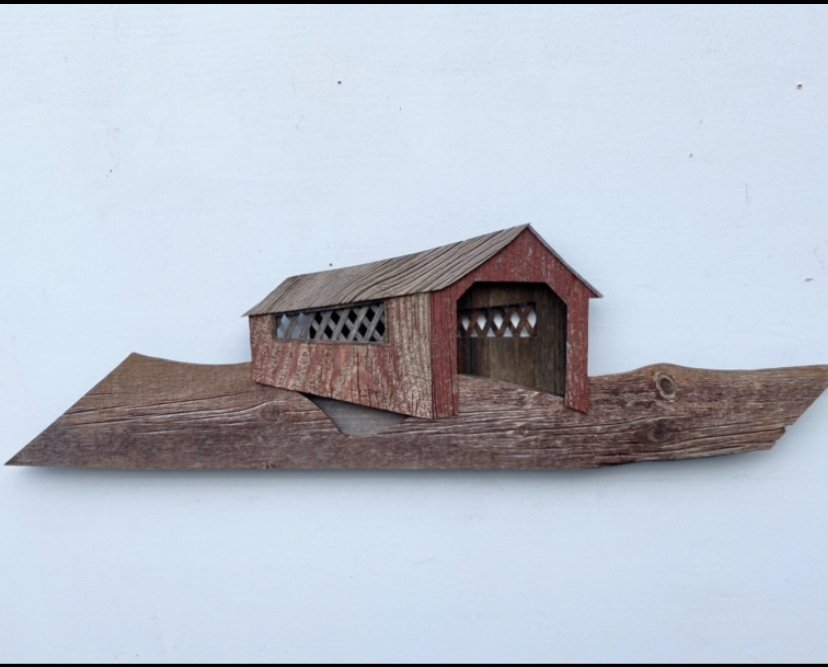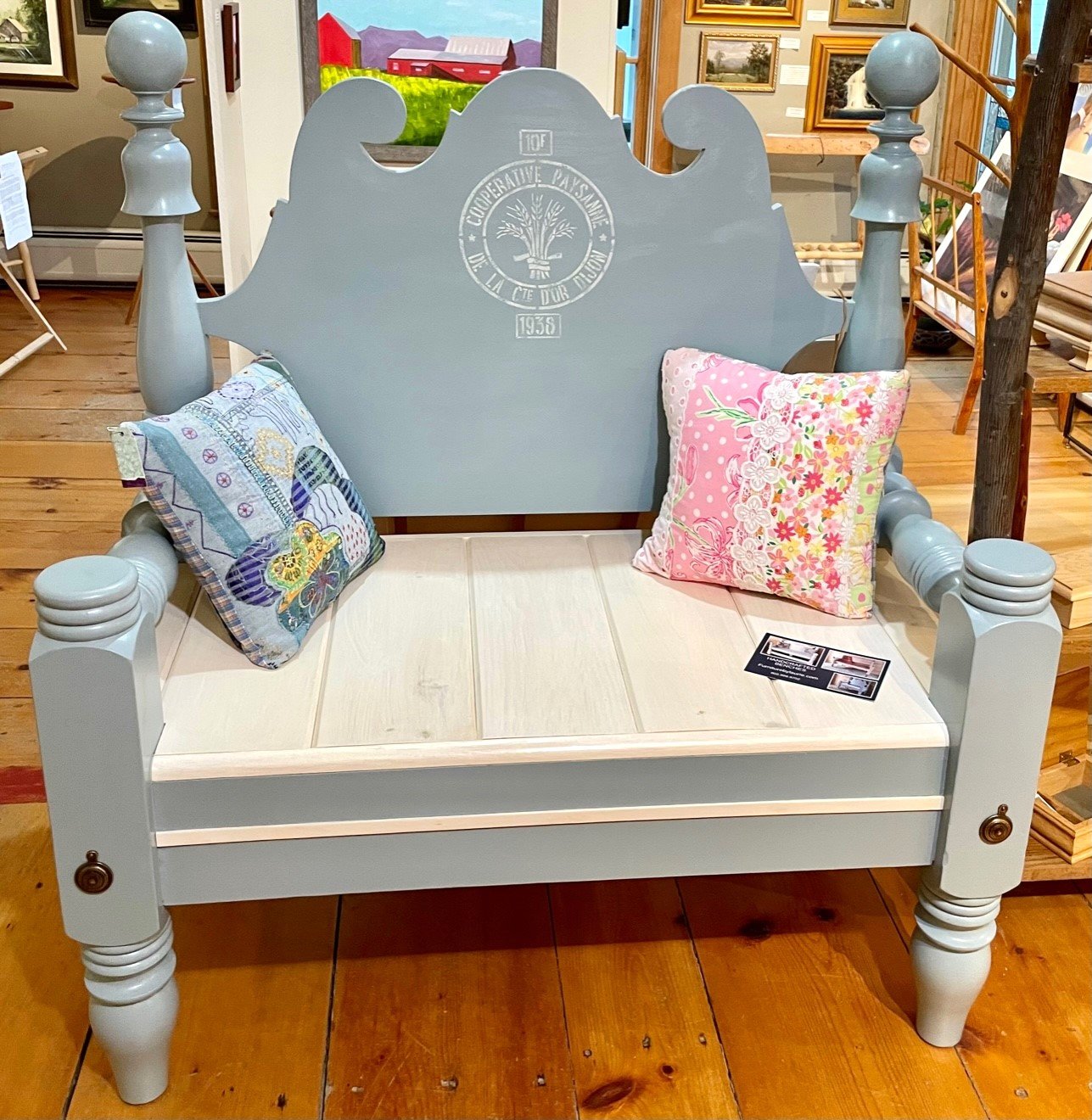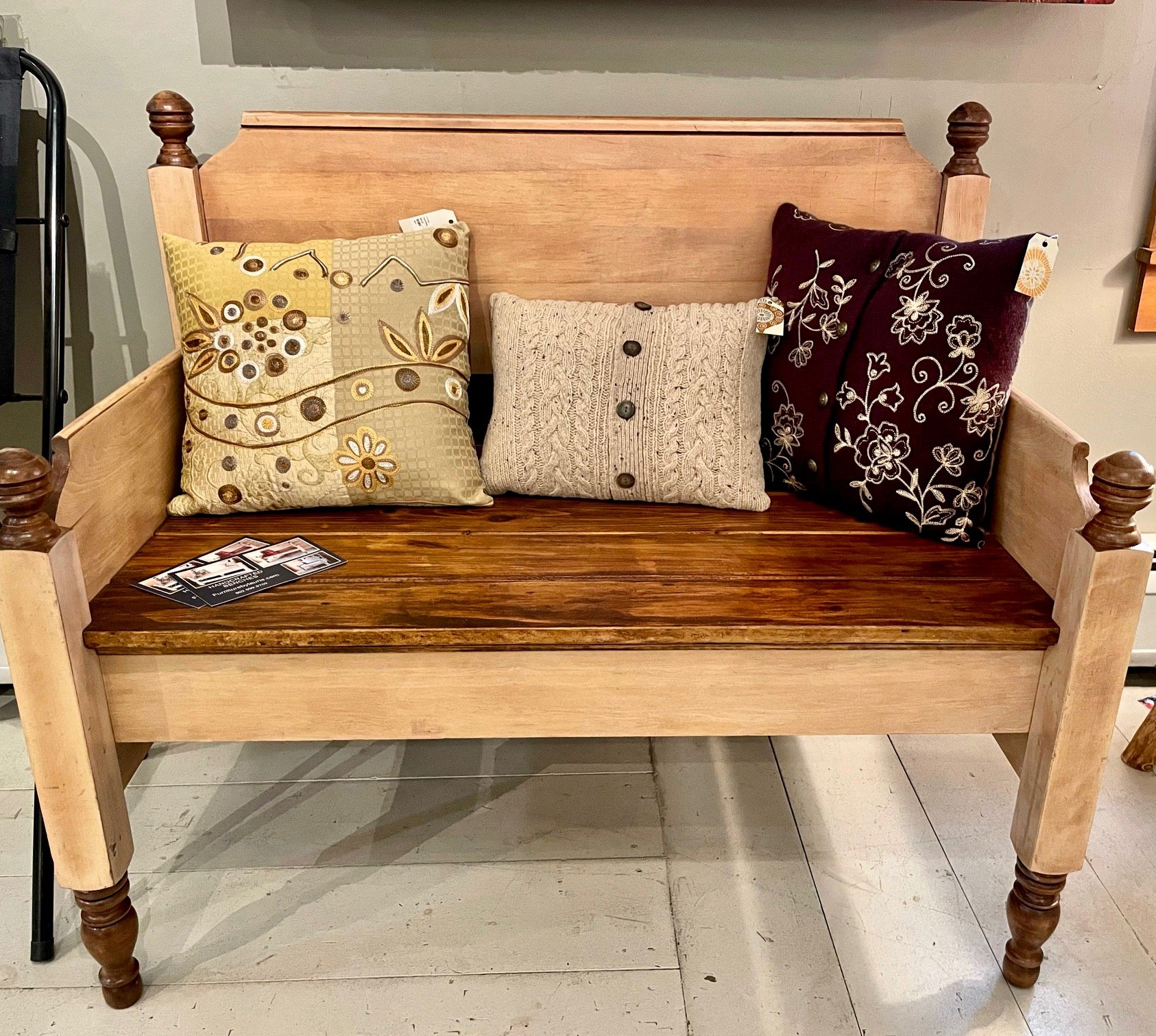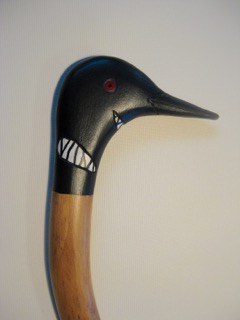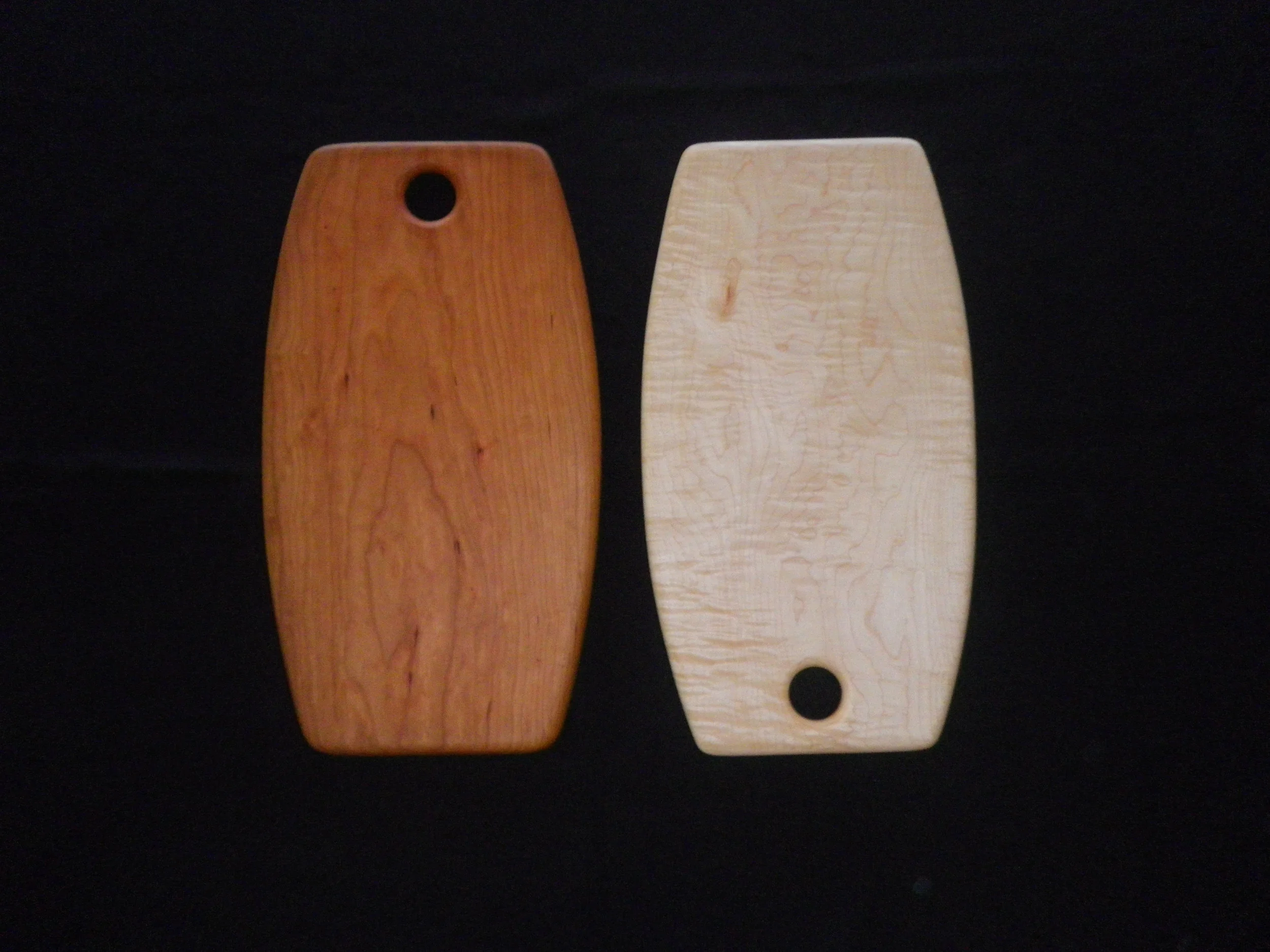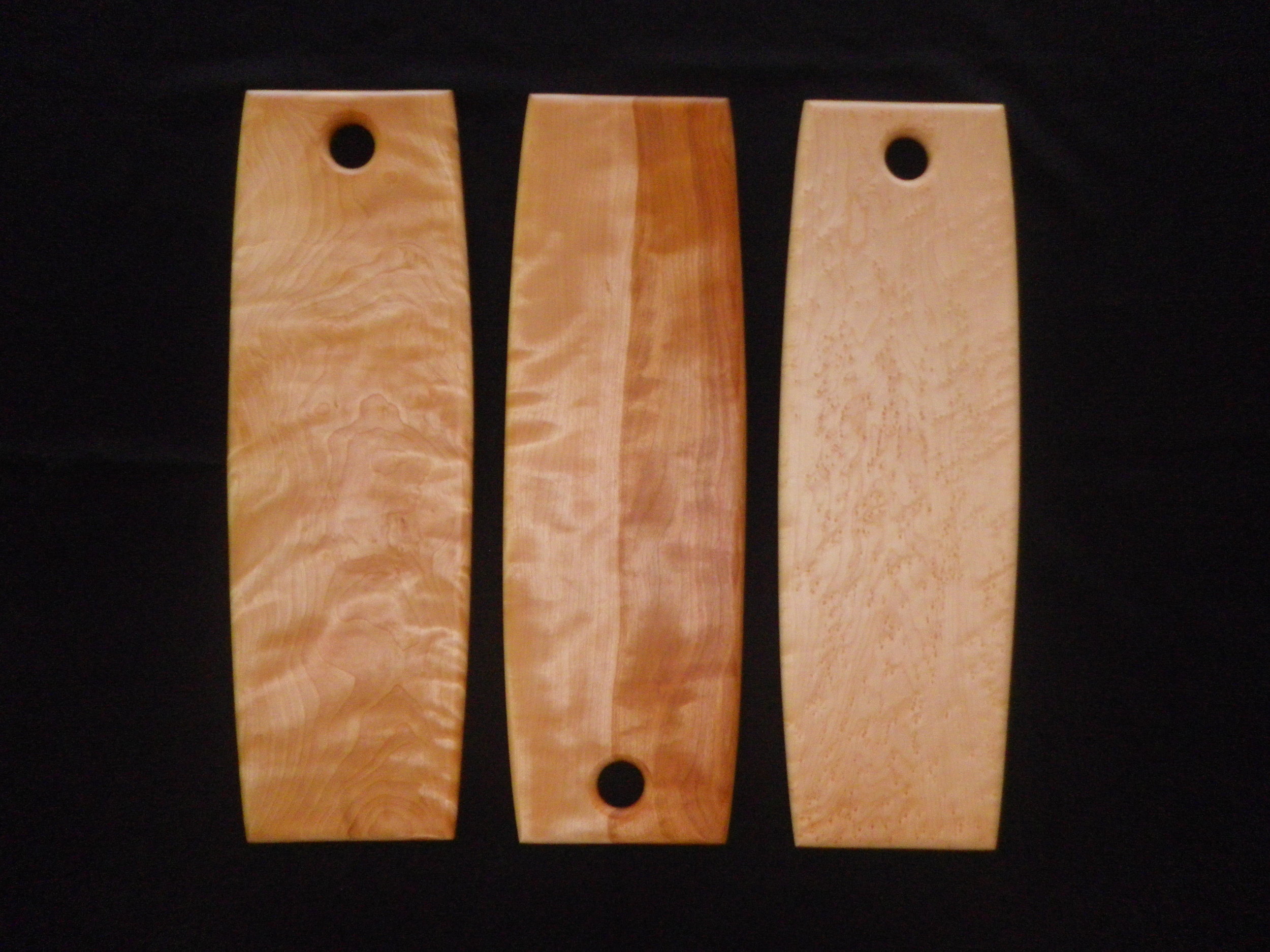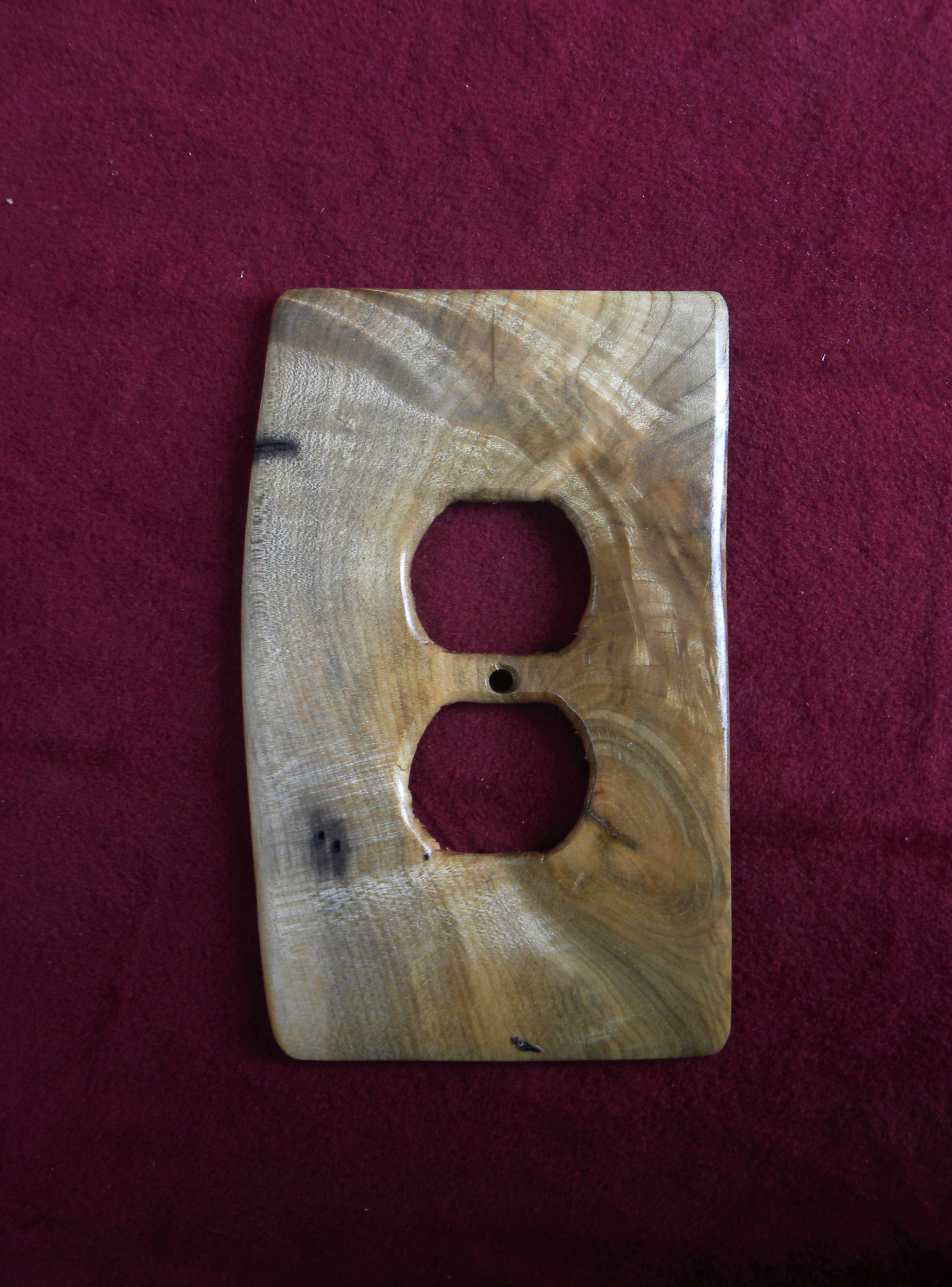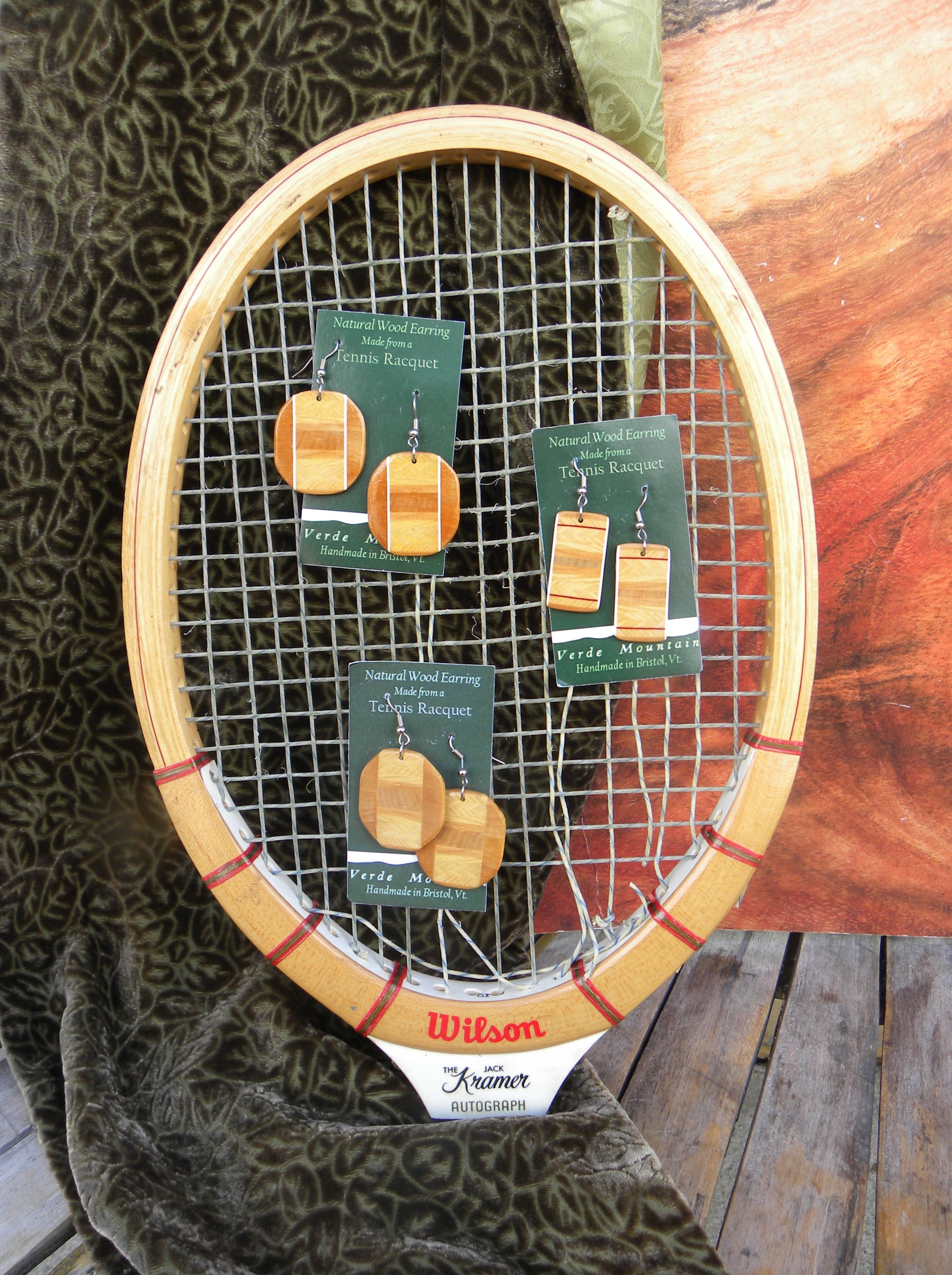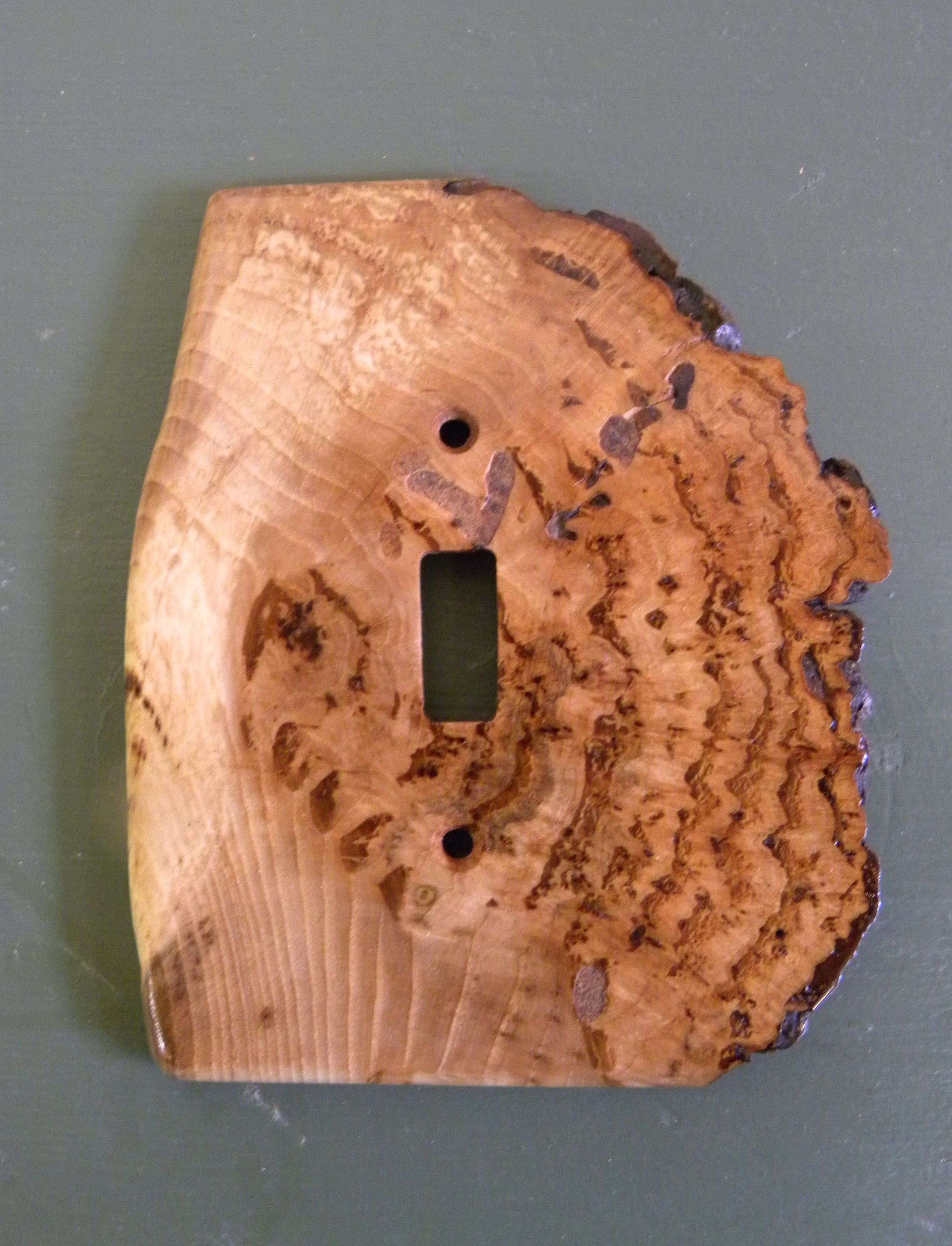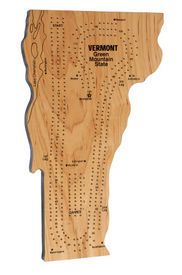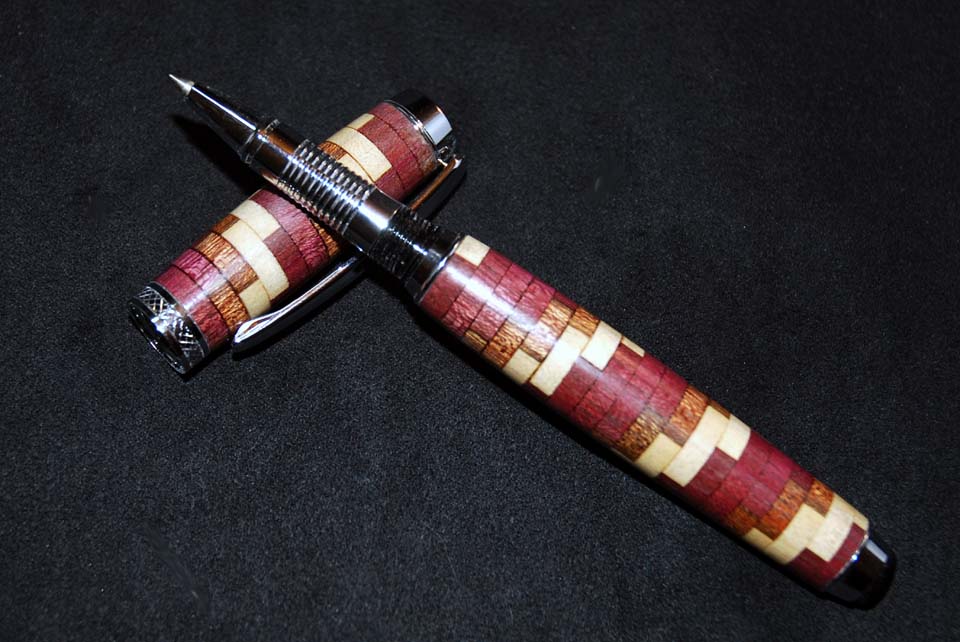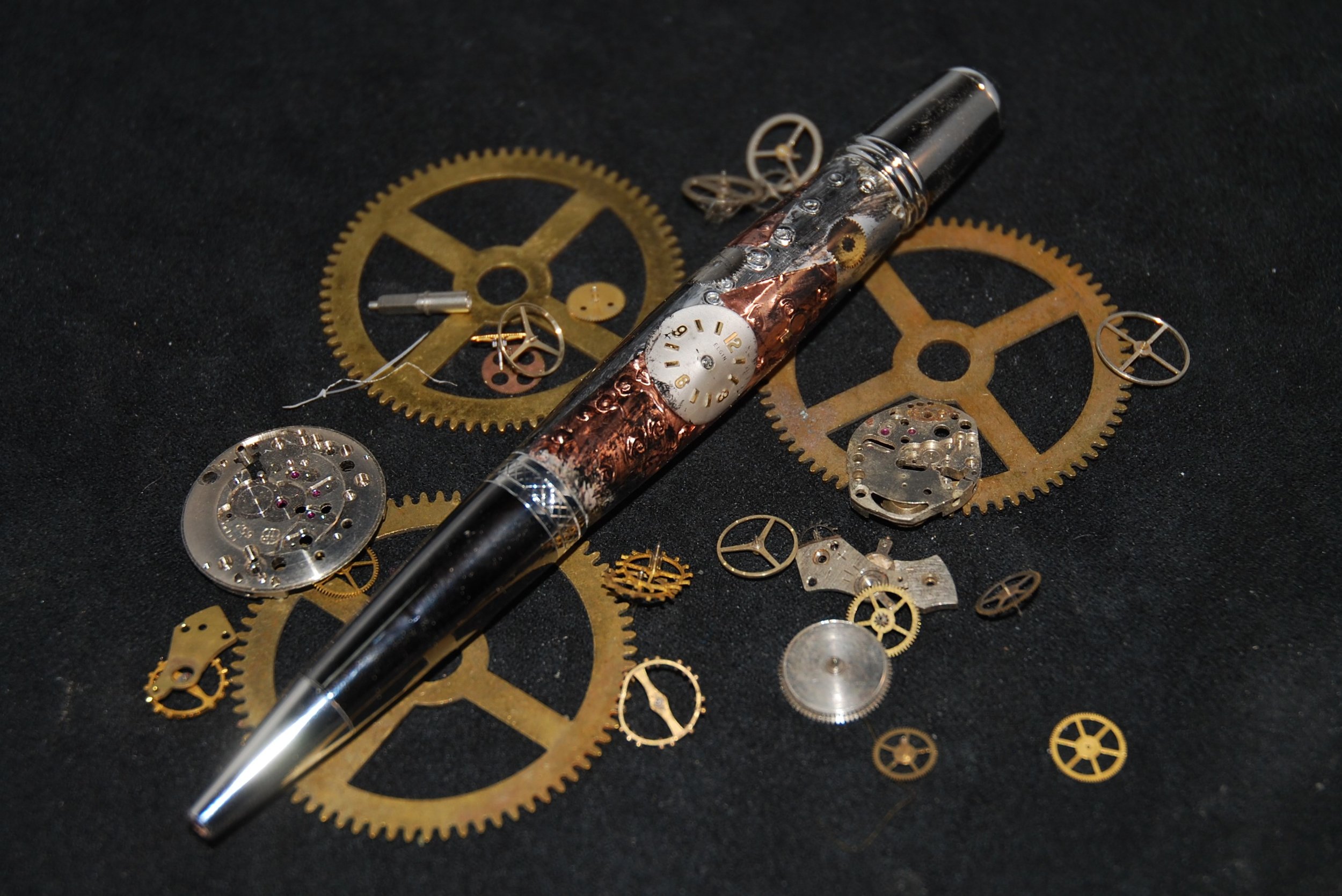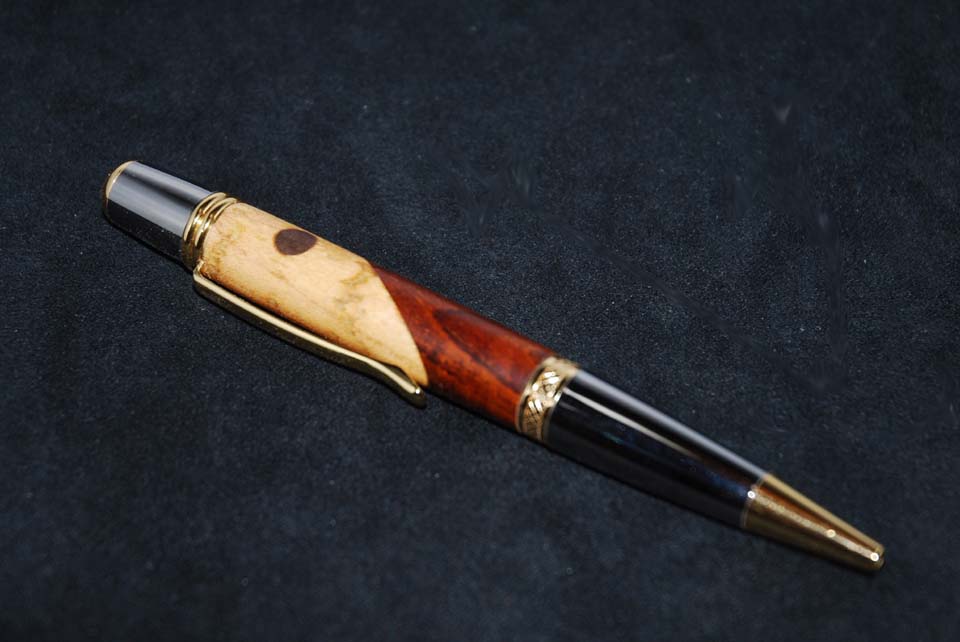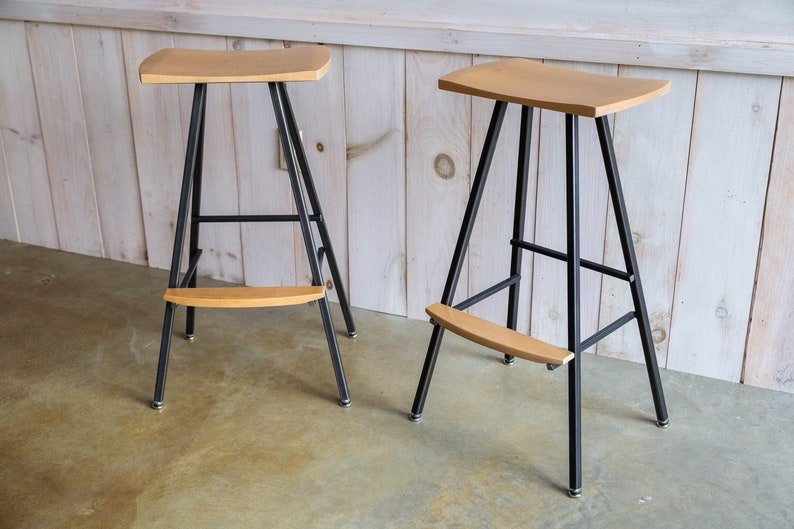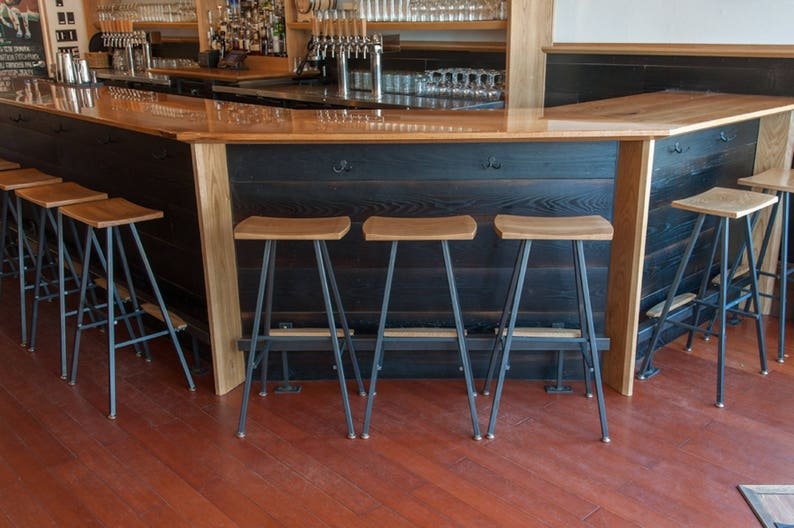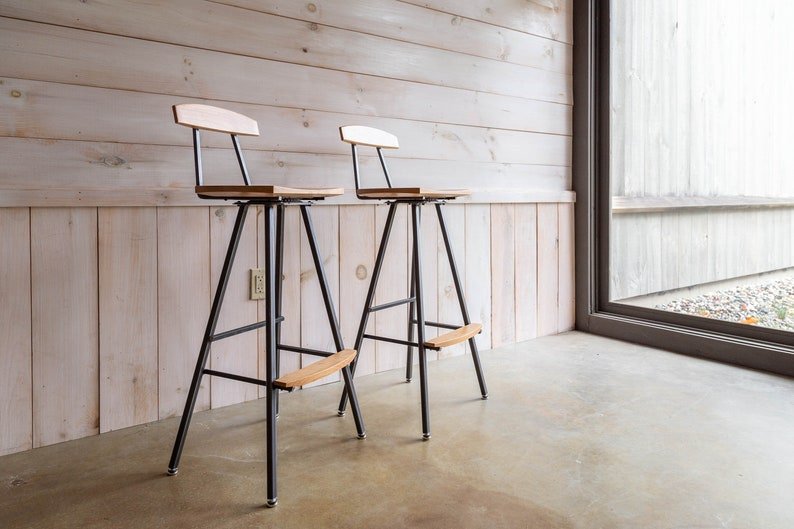METAL
Chris Eaton
Custom metal work and design
Linda Phelps
Linda is a long-time Vermont crafter whose robot sculptures are a nod to New England’s industrial past. Linda repurposes salvaged and antique pieces to create her whimsical robot dolls. Watches, broken jewelry, keys, radio components, doll parts and gears top the list, but Linda adds coins, bells and whistles too. Each piece is unique and has its very own personality.
Christian Schoenig
I create sculptures from the cast-off, worn out bits of the industrial world. I source raw materials from old farm dumps, scrap metal dumpsters, small engine repair shops, generous local mechanics and the like.
My shop is basic. It isn’t wired for electricity so I run an extension cord from my house to power my equipment. My tools consist of angle grinders to cut, grind and clean the metal, a small torch and hammers to heat and bend material to shape and a MIG welder to put it all together. Rather than pre-plan my creations, I let metal and process guide me. I know the general subject, but shape, size and structure are revealed as I work.
My sculptures are beasts of land, sea, air and myth. I love the process of taking cold industrial bits and transforming them into works of art that represent organic living creatures in the natural world.
Aaron Stein
I have always had a passion for automobiles and my artwork examines the love/hate relationship automotive consumerism forces us all to experience. I ask myself how can something which has such strongly influenced the design of our landscape while at the same time incurring major environmental degradation become our present way of life?
Between all the negative impacts automobiles have on our present-day society and the rose-colored nostalgic car memories we hold dearly such as family vacations, first kisses, or just cruising around with friends with your first taste of freedom, my work chooses to focus on the conflict between both ends of the spectrum.
License plates, especially older weathered ones, are full of character and grab my attention. The state, date, numbers and letters all are ripe with associations. They become familiar icons and everyone has their own experiences they can identify by year or state of the license plate. In my work I choose to use license plates as my main medium to express the melancholy feeling I hold about the automobile and its esteemed rank in our society.
I draw inspiration from the Surrealist and Dada movements, most especially Joseph Cornell. I am compelled to produce my work and I create a very personal view using common objects. Scavenging materials, drawing, photography, painting, sculpting, wood & metal working, buying, collecting and wrecking toys are all part of my non-traditional creative process.
I hope you enjoy my work as much as I enjoy putting it out there.
WOOD
Alexander's Door Knockers
Alexander's door knockers are entirely handmade from weather-proofed pine and birch. Individually made by artist Terry Borsman.
Randy Allen
Artist Statement:
Part of the intrigue of building in the rustic or “organic” style is that wood has such a natural beauty unto itself that it seems like half my work is already done, and my job is just to bring the elements together in some form. I love walking in the woods and along stream banks and discovering materials, and also that first saw cut through a burl or a log when its grain is revealed. It’s these grains, textures, colors and shapes, which inspire me.
My particular style has evolved over 30 something years of doing carpentry and woodworking; the more organic elements creeping in over the years. The most organic pieces take the form of medicine chests, chests of drawers, railing systems and even spiral staircases. They feel like a gift of nature to me and I hope they feel like they have come from the deep woods and speak of the earth.
-Randy Allen
John Armstrong
There are no rules! The final look and shape of my pieces come from the wood as much as from me. The piece is transformed from a living forest tree to unique, warm, friendly functional household furniture.
Neil Dominiecki
Scott Duffy - Rockledge Farm Woodworks
“Unlocking the beauty of Native Hardwoods". With a four generation Heritage of woodworking at Rockledge Farm, Scott Duffy and son Ian have now been making wooden wares and furniture here since the early 1980’s. On a 200 year old “hill farm” near the family’s original 1700’s settlement, they craft a wonderful selection of furniture and gifts in the finest hardwoods and burls native to this area, using converted barns for workshops and Gallery, From Salad Bowls turned from solid blocks of beautifully grained Cherry, unique Cutting/Serving Boards crafted from single planks or Figured Hardwoods, Carriers with intricately figured Birdseye Maple, Food Serving Utensils carved in Cherry Heartwood, to stunning One-of-a-kind Fine Furniture, they use woods which have been harvested in a responsible, sustainable manner. Their functional designs are carefully fashioned using time-proven methods, producing items that will be enjoyed and used for generations.
Jonathan Draught
I have been making animal sculpture for over 30 years, mostly with the subtractive method using a chainsaw and carving white pine, but working in plasticine clay to make models for them. Now, I find working with terra cotta clay a better way to express my love and admiration for animals and a good medium for permanence. Realism is my aim but sometimes it’s fun to anthropomorphize them a little to make useful items or just to be whimsical. Bears are universally iconic and comprise most of my work but every creature is unique and worthy of attention and I enjoy making special orders for people.
I live and work in the backwoods of Warren, VT near Blueberry Lake, surrounded by nature, and enjoy making music, carving, painting and rambling about.
Jim Geier
The Vermont Folk Rocker was designed in 1974 by Jim Geier. Shaker inspired, the chair developed out of a desire for a simple classic aesthetic. The design has been well tested throughout the years, resulting in a handcrafted rocking chair with a rich wood texture of the highest quality, intended to last for generations.
The Vermont Folk Rocker is constructed out of solid hardwood in the choice of Cherry, Red Oak, Bird’s Eye Maple or Black Walnut. The chair’s seat and back are made of wooden blocks that are strung through the frame with 5/16 nylon rope. These blocks adjust for you as you sit, feeling more like an upholstered seat than solid wood. We offer two sizes, the Regular and Tall/Wide.
Kevin Kelley
Raised in New England, Kevin started his woodworking career working with a furniture maker in New Haven, Connecticut. After 8 years of work, it was time to travel. Kevin started turning in the early 80s in Hawaii, he turned Koa, Mango, Kamani, Milo, are a few of the woods he turned. As time went by a wife and kids arrived and the search for more local woods persisted. After 30 years on the island, he was granted access to a private ranch at the 7000’ elevation and the opportunity to cut Koa from the stumps of long ago cut Koa trees. All the wood he cut was wet and turned thick and waxed to force drying from the inside to prevent cracking. After a year or more of air drying, these turnings are put into a kiln and driven down to 10% moisture. Moving back to New England to Starksboro, Vermont with all these roughed out turnings, which at this point are remounted on the lathe and brought to final form and finish. These turnings are now available in local galleries as well as galleries in Hawaii.
Terrance Hutchinson
John Long
Artist’s Statement
Since developing my art in 1970, my work has evolved from smaller, framed works to the large, free-form sculptural pieces they are now. The medium is wood; however, the wood I use has been weathered by time and the elements, giving it an endless change of shadows, light and color. The aging of wood, usually thought to be unfortunate, is really nature’s triumph and worth regarding with the same artistic vision.
The weathered wood I use in my work is from early American barns, many of which are in excess of 100 years old. I start with a sketch on paper, then transfer the design to pieces of wood that have varying colors and textures. Every piece is cut freehand on a band-saw. Using the grain and different colors of wood, each scene is meticulously fit together, forming what “appears” to be a three-dimensional interpretation.
My inspiration for this work originates from architecture I have seen, and from a desire to portray the character of these early American structures. Eric Sloane wrote about our vanishing barns in North America, and like his, I hope my work will help preserve the integrity of these fine buildings for generations to come. Every piece of wood I use in creating these scenes has a history.
Laurie McBurnie
East Hardwick, in Vermont’s Northeast Kingdom is where carpenter/designer Laurie McBurnie creates her benches from reclaimed wood and parts from vintage furniture. Each bench is unique, solidly built and hand finished, using high quality paints and stains.
Wooden Wings by Phillip Morgan
Born in Rhode Island and growing up in Connecticut, Phil Morgan, is a 14th generation Yankee. Since age 13 he’s had a knife in his pocket and at any chance would whittle or carve. After college, while working for the National Park Service in California, Phil began specializing in realistic bird sculptures. Returning to his New England roots, Phil and his wife Lynn settled in Athens, Vermont in 1980 to build their cabin and raise a family.
While his full bodied, life sized carvings were popular, the blocks of time they called for were hard to find after his kids arrived. He started searching for a product he could produce that would satisfy his urge to carve birds. In 2001 he began producing his “FEATHERED FRIENDS BACKSCRATCHERS”. These backscratchers have become today’s Folk Art, as they not only serve a purpose but are pleasing to the eye.
Having reached retirement age Phil looks forward to more time for his craft and hopes to also return to creating full bodied sculptures as well as his backscratchers.
Jerome Milks
From Tree to Table... crafting artisan serving and cutting boards for discerning kitchens and spirited tables. I start with local hardwoods which have been sustainably harvested. I search the racks and bundles at a local family run sawmill that has been in business for over a century. I look for rough boards that have unique figured and grain patterns which help to produce one of a kind finished pieces. When designing and crafting the boards I adhere to the concepts of simplicity, function, and aesthetics and work with each one until there is nothing left to take away. The results are boards which have fine lines and calm and peaceful presences, yet boards which will provide many years of service with minimal care.
All boards are made from a single piece of solid stock which helps to assure that wood tones and figuring are consistent throughout the entire piece as well as being prone to wear slowly and evenly. Much time and attention to detail is giving to the finishing process which allows for each piece to be morphed into an art object that is both graceful and balanced. Several hand rubbed coats of mineral oil and beeswax are then applied to provide a food safe and silky smooth surface that offers protection, yet feels good to the touch. Each finished piece is intended to be both elegant and appealing.
Reed Prescott
Not sure if Reed a native Vermonter as his family moved to this area in the 1750's when it was still part of New Hampshire but his work and life has revolved around this region. Starting as a fine artist who illustrated numerous Vermont Nature Books, Won 2 Vermont Waterfowl Stamp competitions, and his oil painting "Twin Maple farms" was selected by the Vermont Department of Agriculture to be "the image of Vermont Agriculture" in 2004.
As life changes evolve in everyone's life painting is less of an option now but stopping an artist from their creativity is a lot like playing wack-a-mole. They just pop up creating something else. Reed's love for the story leads him to create from wood with history or that stimulates memories in the patron. Asked to sell his wood earrings and other products at a National Woman's Youth Hockey Tournament in South Burlington several years ago he had the creative nudge to make some from old wooden hockey sticks. He was so impressed with the patterns in the layers of glued wood that he started cutting up everything in sight. Tennis rackets, field hockey sticks, canoe paddles, golf clubs and more found his saw. Loving the story each triggered in his life he started looking for historical wood. Apple from Robert Frost's backyard, Posts removed from Shelburne Museum's Ticonderoga, quarter-sawed oak removed during the restoration of the very first house built at Shelburne farms found its way into his collection.
Now he runs Verde Mountain where "we create so that your story lives on" Making a variety of products from storied woods and loves taking wood from customers and custom-made products or gifts from their wood. Most pieces are displayed on nice cards with their story printed on the card. He lives in Lincoln Vermont with his wife and 2 grown sons nearby.
Patrick Russo
David Scrase
David Scrase first turned a bowl in the 1950s. His first lathe was an old treadle sewing machine--there was no electricity in his family’s home in Upton, England. Unable at that tender age to do two things at the same time, he engaged his poor mother to treadle while he turned. In the 1990s he finally sprang for a cheap Delta lathe, which served him well for a few years. Then, in 1999, he bought a Oneway lathe, which was shipped to the Chebeague Island, Maine, where he has been turning ever since.
Most of the wood David uses comes from Chebeague Island and Vermont. The wood is usually still green. When green wood ages, it sometimes becomes “spalted.” That is to say, the wood changes color and often takes on erratic lines delineating where the wood will begin to rot. Sometimes he chooses to leave the wood’s bark as the edge of a bowl. Such vessels are called “live-edge” or “natural edge” bowls. He likes to work with “defects, making a virtue out of necessity. He also loves to work with driftwood.
Larry Simons
I love old ramshackle wooden structures with their lean-tos and additions, especially barns with weathered gray siding and red trim. Rather than re-coloring anything, I prefer to work with the palette I find - so I always have an eye out for broken down farm buildings from which I can scavenge fragments. While living in the west, I fell in love with the raw beauty of the mountains and the desert. I was particularly drawn to unrestored ghost towns and the remnants of the mines they had grown up around where I found rusted metal with a reddish tone not seen in damper climates and deeply grained shards of wood which had hardened with age in the dry air.
Driftwood is one of my favorite collectibles, especially painted pieces which have been tumbled to perfection. A recycler by nature, virtually everything I use in my art has had a previous life – bobbins, chair spindles, tool handles, toys, croquet sets and wooden patterns from steel mills-most of which is brought to me by packrat-types who enjoy seeing what I do with their treasures. Bits and pieces of things that are fun to look at are spread throughout my studio so I can see as many as possible at a glance. I constantly move them around making different combinations on my worktables until I’m satisfied with an assemblage. A visual version of perfect pitch seems to guide me as I tweak a piece to completion.
Sleeping Bear Woodworking
Gary Walz
Gary Walz is a lifelong wood worker who has turned his attention to the art of crafting fine writing instruments for the past 10 years. Easily learned, but never mastered, pen making challenges him because of the endless possibilities of incorporating materials, colors and designs. In addition to woods Gary uses materials as diverse as acrylics, metals, pine cones, acorns, bottle caps, rice, sea shells and watch parts. Gary works out of his home studio in Milton, Vermont, and harvests the majority of his materials from his own property as well as from nature.
Eyrich Stauffer
Eyrich is owner of Stauffer Woodworking, and enjoys taking on a variety of creative projects ranging from furniture and cabinetry to tree houses, homes, and restaurants. Eyrich has also taught woodworking at Sterling College and the Center for Furniture Craftsmanship and has served on the Yestermorrow Board of Directors. He lives in East Montpelier VT.




